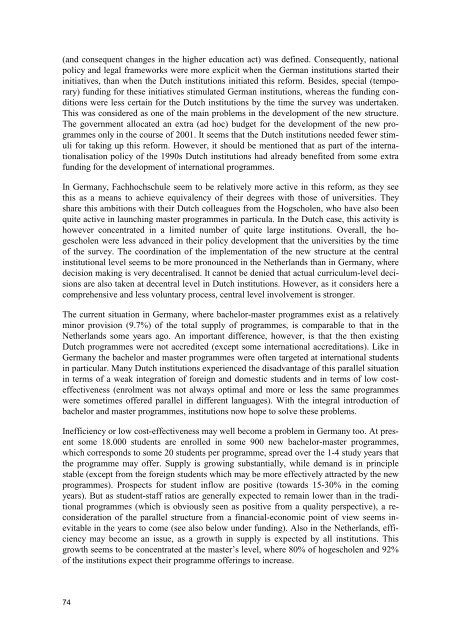and Master Programmes in German Higher Education Institutions
and Master Programmes in German Higher Education Institutions
and Master Programmes in German Higher Education Institutions
- No tags were found...
You also want an ePaper? Increase the reach of your titles
YUMPU automatically turns print PDFs into web optimized ePapers that Google loves.
(<strong>and</strong> consequent changes <strong>in</strong> the higher education act) was def<strong>in</strong>ed. Consequently, nationalpolicy <strong>and</strong> legal frameworks were more explicit when the <strong>German</strong> <strong>in</strong>stitutions started their<strong>in</strong>itiatives, than when the Dutch <strong>in</strong>stitutions <strong>in</strong>itiated this reform. Besides, special (temporary)fund<strong>in</strong>g for these <strong>in</strong>itiatives stimulated <strong>German</strong> <strong>in</strong>stitutions, whereas the fund<strong>in</strong>g conditionswere less certa<strong>in</strong> for the Dutch <strong>in</strong>stitutions by the time the survey was undertaken.This was considered as one of the ma<strong>in</strong> problems <strong>in</strong> the development of the new structure.The government allocated an extra (ad hoc) budget for the development of the new programmesonly <strong>in</strong> the course of 2001. It seems that the Dutch <strong>in</strong>stitutions needed fewer stimulifor tak<strong>in</strong>g up this reform. However, it should be mentioned that as part of the <strong>in</strong>ternationalisationpolicy of the 1990s Dutch <strong>in</strong>stitutions had already benefited from some extrafund<strong>in</strong>g for the development of <strong>in</strong>ternational programmes.In <strong>German</strong>y, Fachhochschule seem to be relatively more active <strong>in</strong> this reform, as they seethis as a means to achieve equivalency of their degrees with those of universities. Theyshare this ambitions with their Dutch colleagues from the Hogscholen, who have also beenquite active <strong>in</strong> launch<strong>in</strong>g master programmes <strong>in</strong> particula. In the Dutch case, this activity ishowever concentrated <strong>in</strong> a limited number of quite large <strong>in</strong>stitutions. Overall, the hogescholenwere less advanced <strong>in</strong> their policy development that the universities by the timeof the survey. The coord<strong>in</strong>ation of the implementation of the new structure at the central<strong>in</strong>stitutional level seems to be more pronounced <strong>in</strong> the Netherl<strong>and</strong>s than <strong>in</strong> <strong>German</strong>y, wheredecision mak<strong>in</strong>g is very decentralised. It cannot be denied that actual curriculum-level decisionsare also taken at decentral level <strong>in</strong> Dutch <strong>in</strong>stitutions. However, as it considers here acomprehensive <strong>and</strong> less voluntary process, central level <strong>in</strong>volvement is stronger.The current situation <strong>in</strong> <strong>German</strong>y, where bachelor-master programmes exist as a relativelym<strong>in</strong>or provision (9.7%) of the total supply of programmes, is comparable to that <strong>in</strong> theNetherl<strong>and</strong>s some years ago. An important difference, however, is that the then exist<strong>in</strong>gDutch programmes were not accredited (except some <strong>in</strong>ternational accreditations). Like <strong>in</strong><strong>German</strong>y the bachelor <strong>and</strong> master programmes were often targeted at <strong>in</strong>ternational students<strong>in</strong> particular. Many Dutch <strong>in</strong>stitutions experienced the disadvantage of this parallel situation<strong>in</strong> terms of a weak <strong>in</strong>tegration of foreign <strong>and</strong> domestic students <strong>and</strong> <strong>in</strong> terms of low costeffectiveness(enrolment was not always optimal <strong>and</strong> more or less the same programmeswere sometimes offered parallel <strong>in</strong> different languages). With the <strong>in</strong>tegral <strong>in</strong>troduction ofbachelor <strong>and</strong> master programmes, <strong>in</strong>stitutions now hope to solve these problems.Inefficiency or low cost-effectiveness may well become a problem <strong>in</strong> <strong>German</strong>y too. At presentsome 18.000 students are enrolled <strong>in</strong> some 900 new bachelor-master programmes,which corresponds to some 20 students per programme, spread over the 1-4 study years thatthe programme may offer. Supply is grow<strong>in</strong>g substantially, while dem<strong>and</strong> is <strong>in</strong> pr<strong>in</strong>ciplestable (except from the foreign students which may be more effectively attracted by the newprogrammes). Prospects for student <strong>in</strong>flow are positive (towards 15-30% <strong>in</strong> the com<strong>in</strong>gyears). But as student-staff ratios are generally expected to rema<strong>in</strong> lower than <strong>in</strong> the traditionalprogrammes (which is obviously seen as positive from a quality perspective), a reconsiderationof the parallel structure from a f<strong>in</strong>ancial-economic po<strong>in</strong>t of view seems <strong>in</strong>evitable<strong>in</strong> the years to come (see also below under fund<strong>in</strong>g). Also <strong>in</strong> the Netherl<strong>and</strong>s, efficiencymay become an issue, as a growth <strong>in</strong> supply is expected by all <strong>in</strong>stitutions. Thisgrowth seems to be concentrated at the master’s level, where 80% of hogescholen <strong>and</strong> 92%of the <strong>in</strong>stitutions expect their programme offer<strong>in</strong>gs to <strong>in</strong>crease.74
















